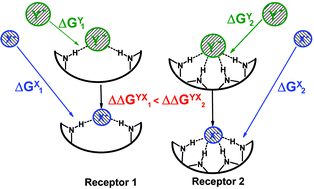Selectivity in supramolecular host–guest complexes†
Abstract
The background of possible selectivity–affinity correlations and their limitations is reviewed, with typical

* Corresponding authors
a
FR Organische Chemie, Universität des Saarlandes, D 66041 Saarbrücken, Germany
E-mail:
ch12hs@rz.uni-sb.de
b
Facultad de Química, Universidad Nacional Autónoma de México, 04510 México D.F., México
E-mail:
anatoli@servidor.unam.mx
The background of possible selectivity–affinity correlations and their limitations is reviewed, with typical

 Please wait while we load your content...
Something went wrong. Try again?
Please wait while we load your content...
Something went wrong. Try again?
H. Schneider and A. K. Yatsimirsky, Chem. Soc. Rev., 2008, 37, 263 DOI: 10.1039/B612543N
To request permission to reproduce material from this article, please go to the Copyright Clearance Center request page.
If you are an author contributing to an RSC publication, you do not need to request permission provided correct acknowledgement is given.
If you are the author of this article, you do not need to request permission to reproduce figures and diagrams provided correct acknowledgement is given. If you want to reproduce the whole article in a third-party publication (excluding your thesis/dissertation for which permission is not required) please go to the Copyright Clearance Center request page.
Read more about how to correctly acknowledge RSC content.
 Fetching data from CrossRef.
Fetching data from CrossRef.
This may take some time to load.
Loading related content
